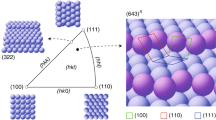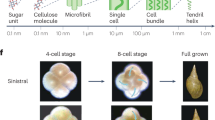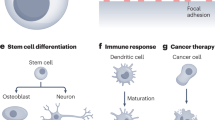Abstract
From synthetic drugs to biodegradable plastics to the origin of life, the chiral selection of molecules presents both daunting challenges and significant opportunities in materials science. Among the most promising, yet little explored, avenues for chiral molecular discrimination is adsorption on chiral crystalline surfaces — periodic environments that can select, concentrate and possibly even organize molecules into polymers and other macromolecular structures. Here we review experimental and theoretical approaches to chiral selection on inorganic crystalline surfaces — research that is poised to open this new frontier in understanding and exploiting surface-molecule interactions.
This is a preview of subscription content, access via your institution
Access options
Subscribe to this journal
Receive 12 print issues and online access
$259.00 per year
only $21.58 per issue
Buy this article
- Purchase on Springer Link
- Instant access to full article PDF
Prices may be subject to local taxes which are calculated during checkout







Similar content being viewed by others
References
Brown, G.E. Jr. et al. Metal oxide surfaces and their interactions with aqueous solutions and microbial organisms. Chem. Rev. 99, 77–174 ( 1998).
Popa, R. A sequential scenario for the origin of biological chirality. J. Mol. Evol. 44, 121–127 ( 1997).
Lahav, N. Biogenesis: Theories of Life's Origins (Oxford Univ. Press, New York, 1999).
Pályi, G., Zucchi, C. & Caglioti, L. (eds.) Advances in Biochirality (Elsevier, New York, 1999).
Jacoby, M. 2-D steroeselectivity. Chem. Eng. News 43–46 ( March 25, 2002).
Weissbuch, I. et al. Separation of enantiomers and racemate formation in two-dimensional crystals at the water surface from racemic alpha-amino acid amphiphiles: design and structure. J. Am. Chem. Soc. 119, 933–942 ( 1997).
Lahav, M. & Leiserowitz, L. Spontaneous resolution: From three-dimensional crystals to two-dimensional magic nanoclusters. Angew. Chem. Int. Edn Engl. 38, 2533–2535 ( 1999).
Weissbuch, I., Addadi, L., Lahav, M. & Leiserowitz, L. Molecular recognition at crystal interfaces. Science 253, 637–644 ( 1991).
Koretsky, C.M., Sverjensky, D.A. & Sahai, N. A model of surface site types on oxide and silicate minerals based on crystal chemistry: Implications for site types and densities, multi-site adsorption, surface infrared spectroscopy, and dissolution kinetics. Am. J. Sci. 298, 349–438 ( 1998).
Stipp, S.L. & Hochella, M.F. Jr. Structure and bonding environments at the calcite surface as observed with X-ray photoelectron spectroscopy (XPS) and low energy electron diffraction (LEED). Geochim. Cosmochim. Acta 55, 1723–1736 ( 1991).
Van Cappellen, P., Charlet, L., Stumm, W. & Wersin, P. A surface complexation model of the carbonate mineral-aqueous solution interface. Geochim. Cosmochim. Acta 57, 3505–3518 ( 1993).
de Leeuw, N.H., Parker, S.C. & Harding, J.H. Molecular dynamics simulation of crystal dissolution from calcite steps. Phys. Rev. B 60, 13792–13799 ( 1999).
Davankov, V.A. The nature of chiral recognition: Is it a three-point interaction? Chirality 9, 99–102 ( 1997).
Lopinski, G.P., Moffatt, D.J., Wayner, D.D.M. & Wolkow, R.A. Determination of the absolute chirality of individual adsorbed molecules using the scanning tunnelling microscope. Nature 392, 909–911 ( 1998).
Pasteur, L. Recherches sur les relations qui peuvent exister entre la forme cristalline et la composition chimique, et le sens de la polarisation rotatoire. Ann. Chim. Phys. 24 (3rd series), 442–459 ( 1848).
Pasteur, L. Nouvelles recherches sur les relations qui peuvent exister entre la forme cristalline, la composition chimique et le phénomène de la polarisation rotatoire. Ann. Chim. Phys. 31 (3rd series), 67–102 ( 1851).
Stinson, S.C. Chiral chemistry. Chem. Eng. News 79, 45–56 ( 2001).
Rouhi, A.M. Chiral roundup. Chem. Eng. News 80, 43–57 ( 2002).
Halasyamani, P.S. & Poeppelmeier, K.R. Noncentrosymmetric oxides. Chem. Mater. 10, 2753–2769 ( 1998).
Tsuchida, R., Kobayashi, M. & Nakamura, A. Asymmetric adsorption of complex salts on quartz. J. Chem. Soc. Jpn 56, 1339 ( 1935).
Karagounis, G. & Coumonlos, G. A new method for resolving a racemic compound. Nature 142, 162–163 ( 1938).
Bonner, W.A., Kavasmaneck, P.R., Martin, F.S. & Flores, J.J. Asymmetric adsorption of alanine by quartz. Science 186, 143–144 ( 1974).
Bonner, W.A., Kavasmaneck, P.R., Martin, F.S. & Flores, J.J. Asymmetric adsorption by quartz: A model for the prebiotic origin of optical activity. Origin of Life 6, 367–376 ( 1975).
Soai, K. et al. d- and l-quartz-promoted highly enantioselective synthesis of a chiral organic compound. J. Am. Chem. Soc. 121, 11235–11236 ( 1999).
Guevremont, J.M., Strongin, D.R. & Schoonin, M.A.A. Thermal chemistry of H2S and H2O on the (100) plane of pyrite: Unique reactivity of defect sites. Am. Mineral. 83, 1246–1255 ( 1998).
McFadden, C.F., Cremer, P.S. & Gellman, A.J. Adsorption of chiral alcohols on “chiral” metal surfaces. Langmuir 12, 2483–2487 ( 1996).
Hazen, R.M., Filley, T.R. & Goodfriend, G.A. Selective adsorption of L- and D-amino acids on calcite: Implications for biochemical homochirality. Proc. Natl Acad. Sci. USA 98, 5487–5490 ( 2001).
Dana, E.S. A Textbook of Mineralogy (Wiley, New York, 1949).
Smyth, J.R. & Bish, D.L. Crystal Structures and Cation Sites of the Rock-Forming Minerals (Allen & Unwin, Boston, 1988).
Sholl, D.S. Adsorption of chiral hydrocarbons on chiral platinum surfaces. Langmuir 14, 862–867 ( 1998).
Power, T.D. & Sholl, D.S. Enantiospecific adsorption of chiral hydrocarbons on naturally chiral Pt and Cu surfaces. J. Vac. Sci. Technol. A 17, 1700–1704 ( 1999).
Sholl, D.S., Asthagiri, A. & Power, T.D. Naturally chiral metal surfaces as enantiospecific adsorbents. J. Phys. Chem. B 105, 4771–4782 ( 2001).
Gellman, A.J., Horvath, J.D. & Buelow, M.T. Chiral single crystal surface chemistry. J. Mol. Catal. A 167, 3–11 ( 2001).
Horvath, J.D. & Gellman, A.J. Enantiospecific desorption of R- and S-propylene oxide from a chiral Cu(643) surface. J. Am. Chem. Soc. 123, 7953–7954 ( 2001).
Horvath, J.D. & Gellman, A.J. Enantiospecific desorption of chiral compounds from chiral Cu(643) and achiral Cu(111) surfaces. J. Am. Chem. Soc. 124, 2384–2392 ( 2002).
Ahmadi, A., Attard, G., Feliu, J. & Rodes, A. Surface reactivity at “chiral” platinum surfaces. Langmuir 15, 2420–2424 ( 1999).
Attard, G.A. et al. Temperature effects in the enantiomeric electro-oxidation of D- and L-glucose on Pt{643}(S). J. Phys. Chem. B 103, 1381–1385 ( 1999).
Attard, G.A. Electrochemical studies of enantioselectivity at chiral metal surfaces. J. Phys. Chem. B 105, 3158–3167 ( 2001).
Attard, G.A., Harris, C., Herrero, E. & Feliu, J. The influence of anions and kink structure on the enantioselective electro-oxidation of glucose. Faraday Discuss. 121, 253–266 ( 2002).
Baiker, A. Progress in asymmetric heterogeneous catalysis: Design of novel chirally modified platinum metal catalysts. J. Mol. Catal. A 115, 473–493 ( 1997).
Blaser, H.U. Enantioselective synthesis using chiral heterogeneous catalysts. Tetrahedron-Asymmetry 2, 843–866 ( 1991).
Blaser, H.U. Heterogeneous catalysis for fine chemicals production. Catal. Today 60, 161–165 ( 2000).
Ferri, D., Burgi, T. & Baiker, A. Chiral modification of platinum catalysts by cinchonidine adsorption studied by in situ ATR-IR spectroscopy. Chem. Commun. 1172–1173 ( 2001).
Bonello, J.M. et al. Fundamental aspects of enantioselective heterogeneous catalysis: a NEXAFS study of methyl pyruvate and (S)-(-)-1-(1- naphthyl) ethylamine on Pt{111}. Surf. Sci. 482, 207–214 ( 2001).
Bonello, J.M. & Lambert, R.M. The structure and reactivity of quinoline overlayers and the adsorption geometry of lepidine on Pt{111}: model molecules for chiral modifiers in enantioselective hydrogenation. Surf. Sci. 498, 212–228 ( 2002).
Lorenzo, M.O., Baddeley, C.J., Muryn, C. & Raval, R. Extended surface chirality from supramolecular assemblies of adsorbed chiral molecules. Nature 404, 376–379 ( 2000).
Zhao, X.Y., Zhao, R.G. & Yang, W.S. Scanning tunneling microscopy investigation of L-lysine adsorbed on Cu(001). Langmuir 16, 9812–9818 ( 2000).
Barbosa, L.A.M.M. & Sautet, P. Stability of chiral domains produced by adsorption of tartaric acid isomers on the Cu(110) surface: A periodic density functional theory study. J. Am. Chem. Soc. 123, 6639–6648 ( 2001).
Chen, Q., Lee, C.W., Frankel, D.J. & Richardson, N.V. The formation of enantiospecific phases on a Cu(110) surface. Phys. Chem. Commun. [online] 9, ( 1999) (doi:10.1039/a905986e).
Chen, Q., Frankel, D.J. & Richardson, N.V. Chemisorption induced chirality: glycine on Cu{110}. Surf. Sci. 497, 37–46 ( 2002).
Amariglio, A., Amariglio, H. & Duval, X. Asymmetric reactions on optically active quartz. Helv. Chim. Acta 51, 2110–2115 ( 1968).
Cody, A.M. & Cody, R.D. Chiral habit modifications of gypsum from epitaxial-like adsorption of stereospecific growth inhibitors. J. Cryst. Growth 113, 508–529 ( 1991).
Babel, M. Crystallography and genesis of the giant intergrowths of gypsum from the Miocene evaporites of Poland. Archiwum Mineralogiczne 44, 103–135 ( 1990).
Orme, C.A. et al. Formation of chiral morphologies through selective binding of amino acids to calcite surface steps. Nature 411, 775–779 ( 2001).
Bally, A.W. & Palmer, A.R. (eds.) The Geology of North America: An Overview (Geological Society of America, Boulder, Colorado, 1989).
Sumner, D.Y. Carbonate precipitation and oxygen stratification in late Archaean seawater as deduced from facies and stratigraphy of the Gamohaan and Frisco Formations, Transvaal Supergroup, South Africa. Am. J. Sci. 297, 455–487 ( 1997).
Weiner, S. & Addadi, L. Design strategies in mineralized biological materials. J. Mater. Chem. 7, 689–702 ( 1997).
Carter, P.W. & Mitterer, R.M. Amino acid composition of organic matter associated with carbonate and non-carbonate sediments. Geochim. Cosmochim. Acta 42, 1231–1238 ( 1978).
Lowenstam, H.A. & Weiner, S. On Biomineralization (Oxford University Press, New York, 1989).
Alzenberg, J., Tkachenko, A., Weiner, S., Addadi, L. & Hendler, G. Calcitic microlenses as part of the photoreceptor system of brittlestars. Nature 412, 819–822 ( 2001).
Horvath, J.D. Enantiospecific Adsorption on Naturally Chiral Copper Surfaces. Thesis, Carnegie-Mellon Univ. ( 2003).
Stinnett, J.A. & Madix, R.J. Molecular adsorption of alkanes on platinum surfaces: A predictive theoretical model. J. Chem. Phys. 105, 1609–1620 ( 1996).
Weaver, J.F. & Madix, R.J. Trapping dynamics of isobutane, n-butane, and neopentane on Pt(111): Effects of molecular weight and structure. J. Chem. Phys. 110, 10585–10598 ( 1999).
Power, T.D. & Sholl, D.S. Effects of surface relaxation on enantiospecific adsorption on naturally chiral Pt surfaces. Top. Catal. 18, 201–208 ( 2002).
Power, T.D., Asthagiri, A. & Sholl, D.S. Atomically detailed models of the effect of thermal roughening on the enantiospecificity of naturally chiral platinum surfaces. Langmuir 18, 3737–3748 ( 2002).
Lipkowitz, K.B., Coner, R., Peterson, M.A., Morreale, A. & Shackelford, J. The principle of maximum chiral discrimination: Chiral recognition in permethyl-beta-cyclodextrin. J. Org. Chem. 63, 732–745 ( 1998).
Jeong, H.C. & Williams, E.D. Steps on surfaces: experiment and theory. Surf. Sci. Rep. 34, 175–294 ( 1999).
Williams, E.D. & Bartelt, N.C. Thermodynamics of surface morphology. Science 251, 393–400 ( 1991).
Asthagiri, A., Feibelman, P.J. & Sholl, D.S. Thermal fluctuations in the structure of naturally chiral Pt surfaces. Top. Catal. 18, 193–200 ( 2002).
Lorensen, H.T., Nørskov, J.K. & Jacobsen, K.W. Mechanisms of self-diffusion on Pt(110). Phys. Rev. B 60, R5149–R5152 ( 1999).
Stolbov, S. & Rahman, T.S. Role of long range interaction in oxygen superstructure formation on Cu(001) and Ni(001). Phys. Rev. Lett. 89, 116101 ( 2002).
Zhao, X.Y. Fabricating homochiral facets on Cu(001) with L-lysine. J. Am. Chem. Soc. 122, 12584–12585 ( 2000).
Schunack, M., Laegsgaard, E., Stensgaard, I., Johannsen, I. & Besenbacher, F. A chiral metal surface. Angew. Chem. Int. Edn Engl. 40, 2623–2626 ( 2001).
Mason, S.F. Extraterrestrial handedness revisited. Origins Life Evol. Biosph. 30, 435–437 ( 2000).
Bonner, W.A. The origin and amplification of biomolecular chirality. Origins Life Evol. Biosph. 21, 59–111 ( 1991).
Bonner, W.A. Terrestrial and extraterrestrial sources of molecular homochirality. Origins Life Evol. Biosph. 21, 407–420 ( 1992).
Bonner, W.A. Chirality and life. Origins Life Evol. Biosph. 25, 175–190 ( 1995).
Clark, S. Polarized starlight and the handedness of life. Am. Sci. 87, 336–343 ( 1999).
Podlech, J. New insight into the source of biomolecular homochirality: An extraterrestrial origin for molecules of life. Angew. Chem. Int. Edn Engl. 38, 477–478 ( 1999).
Bailey, J. et al. Circular polarization in star-formation regions: Implications for biomolecular homochirality. Science 281, 672–674 ( 1998).
Rikken, G.L.J.A. & Raupach, E. Enantioselective magnetochiral photochemistry. Nature 405, 932–935 ( 2000).
Salam, A. The role of chirality in the origin of life. J. Mol. Evol. 33, 105–113 ( 1991).
Engel, M.H. & Macko, S.A. Isotopic evidence for extraterrestrial non-racemic amino acids in the Murchison meteorite. Nature 389, 265–268 ( 1997).
Cronin, J.R. & Pizzarello, S. Enantiomeric excesses in meteoric amino acids. Science 275, 951–955 ( 1997).
Pizzarello, S. & Cronin, J.R. Non-racemic amino acids in the Murray and Murchison meteorites. Geochim. Cosmochim. Acta 64, 329–338 ( 2000).
Avetisov, V.A., Goldanskii, V.I. & Kuz'min, V.V. Handedness, origin of life and evolution. Phys. Today 44, 33–41 ( 1991).
Avetisov, V.A. in Advances in Biochirality (eds Pályi, G., Zucchi, C. & Caglioti, L.) 69–84 (Elsevier, New York, 1999).
Cintas, P. Chirality of living systems: a helping hand from crystals and oligopeptides. Angew. Chem. Int. Edn Engl. 41, 1139–1145 ( 2002).
Chela-Flores, J. The origin of chirality in protein amino acids. Chirality 6, 165–168 ( 1994).
Bolli, M., Micura, R. & Eschenmoser, A. Pyranosyl-RNA: chiroselective self-assembly of base sequences by ligative oligomerization of tetranucleotide-2',3'-cyclophosphates (with a commentary concerning the origin of biomolecular homochirality). Chem. Biol. 4, 309–320 ( 1997).
Lippmann, D.Z. & Dix, J. in Advances in Biochirality (eds Pályi, G., Zucchi, C. & Caglioti, L.) 85–98 (Elsevier, New York, 1999).
Saghatelian, A., Yokobayashi, Y., Soltani, K. & Ghadiri, M.R. A chiroselective peptide replicator. Nature 409, 797–801 ( 2001).
Eckert, C.J. et al. Synthesis of chiral phases in monolayer crystals of racemic amphiphiles. Nature 362, 614–616 ( 1993).
Frondel, C. Characters of quartz fibers. Am. Mineral. 63, 17–27 ( 1978).
Evgenii, K. & Wolfram, T. The role of quartz in the origin of optical activity on Earth. Origins Life Evol. Biosph. 30, 431–434 ( 2000).
Sljivancanin, Z., Gothelf, K.V. & Hammer, B. Density functional theory of enantioselective adsorption at chiral surfaces. J. Am. Chem. Soc. 124, 14789–14794 ( 2002).
Brown, G.E. How minerals react with water. Science 294, 67–69 ( 2001).
Wang, X.-G., Chaka, A. & Scheffler, M. Effect of environment on α-Al2O3 (0001) surface structures. Phys. Rev. Lett. 84, 3650–3653 ( 2000).
Giordano, L., Goniakowski, J. & Suzanne, J. Partial dissociation of water molecules in the (3x2) water monolayer deposited on the MgO (100) surface. Phys. Rev. Letter 81, 1271–1273 ( 1998).
Hass, K.C., Schneider, W.F., Curioni, A. & Andreoni, W. The chemistry of water on alumina surfaces: Reaction dynamics from first principles. Science 282, 265–268 ( 1998).
Dieluweit, S., Ibach, H., Giesen, M. & Einstein, T.L. Orientation dependence of step stiffness: Failure of SOS and Ising models to describe experimental data. Phys. Rev. Lett. 121410(R) ( 2003).
Acknowledgements
R.M.H. has been supported by the NASA Astrobiology Institute and the Carnegie Institution of Washington. D.S.S. has been supported by the National Science Foundation.
Author information
Authors and Affiliations
Corresponding author
Ethics declarations
Competing interests
The authors declare no competing financial interests.
Rights and permissions
About this article
Cite this article
Hazen, R., Sholl, D. Chiral selection on inorganic crystalline surfaces. Nature Mater 2, 367–374 (2003). https://doi.org/10.1038/nmat879
Issue Date:
DOI: https://doi.org/10.1038/nmat879
This article is cited by
-
A natural biogenic nanozyme for scavenging superoxide radicals
Nature Communications (2024)
-
Bioinspired chiral inorganic nanomaterials
Nature Reviews Bioengineering (2023)
-
Condensation and asymmetric amplification of chirality in achiral molecules adsorbed on an achiral surface
Nature Communications (2023)
-
Planar chiral metasurfaces with maximal and tunable chiroptical response driven by bound states in the continuum
Nature Communications (2022)
-
Helical Nonfouling Polypeptides for Biomedical Applications
Chinese Journal of Polymer Science (2022)



